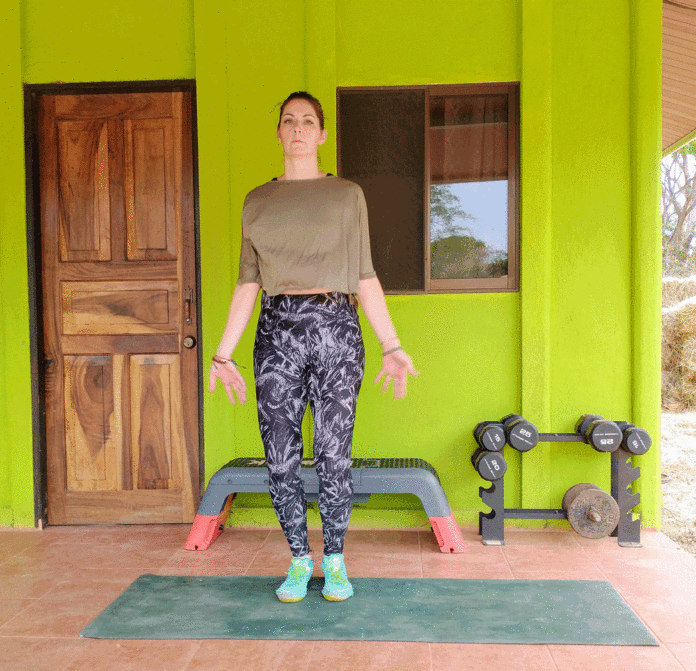How to lose belly fat with exercise
So here’s the deal: as much as you may want to carve the six-pack of your dreams by adding some planks to your daily life or using a ab-crunching machine, it’s just not going to happen.
If you haven’t yet caught on to the fact that infomercial ab products don’t work, it’s time to start paying more attention.
As unfair as it might seem, spot reduction (that is, losing weight in one specific area of your body by doing exercises that focus on that body part) isn’t directly possible.
The only way to get lean abs is to get lean around your whole body
That said, losing belly fat, especially if you tend to put more fat on around your waist than your hips or thighs, is an important health-related goal.
And while direct spot-reduction isn’t possible, there are styles of workouts that are more effective at reducing that “spare tire.” Here’s what you need to know to get started.
Why belly fat is dangerous
Look around and you’ll probably notice that different people tend to gain weight in different areas of their body.
Some people have a pear shape, with a larger lower half, while others pack on the pounds around the waist in a classic apple shape.
To some degree, this is genetic, and there’s not much you can do about your family’s hereditary body shape. But regardless of your genetics, if you continue to gain body fat over time and fail to control the gain with diet and exercise, you’re likely see more fat accumulation around your middle.
This belly fat, known as visceral fat, is associated with a greater risk for health problems.
“Visceral fat is a type of fat stored deep inside the body that surrounds vital abdominal organs like the liver, stomach, and small intestines,” explains Lauren Dal Farra, MD, a cardiologist and CEO of Palm Health in St. Louis. “Excess belly fat increases the risk of chronic diseases such as high blood pressure, stroke, type 2 diabetes, and some types of cancers, such as prostate cancer.”
The problem with visceral fat, which is different from the subcutaneous fat that’s found in other areas of the body, is that it impacts hormone production related to hunger and insulin resistance.
“Increased belly fat increases levels of leptin and decreases levels of adiponectin,” says Dr. Dal Farra. “Leptin is a hormone that causes hunger, so when chronically elevated, it can lead to overeating and more long-term weight gain. Adiponectin plays a role in protecting against insulin resistance and diabetes, as well as heart disease.”
If your levels of adiponectin are chronically reduced, you’re more susceptible to developing these diseases.
And as if these challenges weren’t enough, Dr. Dal Farra emphasizes that excess fatty acids in the belly are absorbed into the bloodstream and are delivered to the liver, which can ultimately cause problems with insulin and cholesterol regulation.
How do you know when you’re in the “danger zone” for belly fat
Here’s the thing to remember: body fat is normal and important. In fact, fat stored (in reasonable amounts) in the belly helps to protect and cushion your vital organs.
But maintaining a healthy body composition (your ratio of fat-free mass to fat mass) is critically important to helping prevent chronic illnesses. Paying attention to your distribution of fat mass—that is, where you put on fat—is important too. Luckily, there are a few quick and easy ways you can gauge how you’re doing.
“You may be in the danger zone [for excess belly fat] if you’re a man with a waist circumference of over 40 inches or a woman with a waist circumference over 35 inches,” says Dr. Dal Farra.
Just keep in mind that most of the data gathered in this area of research has been done on Caucasian populations, and researchers have determined that ethnic background plays a role in belly fat-related risks.
While more specific numbers aren’t known for every ethnic group, Asian populations, in particular, tend to see an increased risk at a smaller waist circumference. According to the Harvard T.H. Chan School of Public Health, this is at roughly 35 inches for men and 31 inches for women.
“Another indicator for women that they may be in the danger zone is if they have a waist-to-hip ratio that’s greater than 1,” says Dr. Dal Farra. “It’s a simple but useful measure of fat distribution that’s calculated by dividing your waist measurement by your hip measurement since the hips are the widest part of your buttocks.”
All you need is a tape measure to do the calculations and get a quick glimpse at your potential risk for belly fat-related disease.
What should you do if you find you are in the danger zone? The good news is you don’t have to stay there. Making changes to your diet and exercise routine can help you shed some of that fat.
Here’s what you need to know.
Take a look at your lifestyle
Stop paying attention to abs myths and start looking for facts.
There’s no ignoring the reality that sedentary lifestyles and poor eating habits play a significant role in fat gain. If you haven’t taken a good, hard look at your current habits (it’s easy to turn a blind eye), it’s time to start.
Start with a fitness tracker. Download a step tracker on your phone or put your Apple Watch or Fitbit to use, then track your baseline activity for seven days.
There’s no need to make over your lifestyle during this week; you simply want to get an honest accounting of where you’re starting.
At the same time, use a meal tracker like MyFitnessPal to track your food, drink, and alcohol consumption for a week. Again, feel free to keep eating and drinking as you usually would.
At the end of the week, go back through each day’s activity and nutrition summaries. Are you less active than you thought? Do you sit for long periods of time without taking a break? Do you stop for takeout more often than you realized?
If you’re not quite sure what you’re doing “right” or “wrong,” take your results to a personal trainer and dietitian to get some feedback. Reasonable tweaks to your daily lifestyle habits can go a long way toward helping you get lean.
HIIT is the best exercise to lose belly fat
To be clear, if you’re not currently exercising, starting any exercise program will help you burn calories, improve your metabolism, and, when combined with a reasonable eating plan, lose fat.
But when it comes to burning belly fat, there does seem to be an optimal approach: high intensity interval training, or HIIT.
“HIIT will preferentially reduce abdominal fat as compared with moderate-intensity exercise,” says Dr. Dal Farra, referencing a study published in 2009 in Metabolic Syndrome and Related Disorders. “HIIT is the most effective type of exercise to burn visceral fat. It’s better to do spurts of high-intensity activity with breaks instead of 30 minutes of a lower-intensity, steady-state exercise if the goal is to reduce visceral fat.”
Dr. Dal Farra points to a 2014 study published in the Journal of Exercise Science & Fitness, in which study participants who completed 20 minutes of HIIT training three days a week for 12 weeks saw a 17 percent reduction in visceral fat.
It’s important to point out is that this reduction in visceral fat isn’t the same thing as “spot reduction.” That’s because HIIT workouts are total-body routines that don’t specifically target one body part.
Rather, HIIT workouts increase total body metabolism significantly, increasing calorie burn during and following a workout. And when HIIT workouts use cardiovascular and muscle-strengthening moves, you’re also building muscle mass, which helps keep your metabolism going 24 hours a day while providing a leaner-looking physique.
“HIIT will also help to increase adiponectin levels and improve cholesterol and blood sugar levels and insulin sensitivity,” says Dr. Dal Farra.
Basically, when it comes to visceral fat, HIIT appears to be an antidote.
Crafting your HIIT routine
There are lots of different ways to craft an effective HIIT routine, but they all have common features—a high-intensity bout of exercise followed by a period of rest (or in some cases, a lower-intensity bout of exercise), with the series repeated for between 15 and 45 minutes.
Generally speaking, shorter workouts include higher-intensity intervals, while longer workouts include lower-intensity (but still challenging) intervals.
It’s completely possible to include HIIT training in every style of workout, but it’s important to have a way to gauge the intensity of your intervals. You might want to use a heart rate monitor to keep track, but it’s not necessary.
What you really need to think about is your rating of perceived exertion, or RPE. This is a scale from zero to 10, where zero is the equivalent of sleeping, while 10 is an all-out sprint at a pace you couldn’t continue for more than about eight to 10 seconds.
To qualify as “high intensity,” your effort level needs to be the equivalent of a seven or higher, based on your own RPE.
For instance, if you want to perform a HIIT running routine, you might alternate between 30 seconds of running at an RPE of eight followed by 30 seconds of walking at an RPE of three, cycling back and forth between the two intervals for a total of 20 minutes. This is a 1:1 work-to-rest ratio, where the work period is the same length of time as the rest period.
Common interval periods are 1:3, 1:2, 1:1, 2:1, and 3:1. The highly popular Tabata style of interval training, for example, includes a 20-second work period and a 10-second rest period, for a 2:1 ratio of work to rest.
If you’re just starting out with HIIT, it’s a good idea to keep your intensity level a little lower, with your rest periods a little longer, to allow for recovery. A 20-second work period with a 40-second rest period (a 1:2 ratio of work to rest) is a good place to start.
Consider the workout below a good example of an at-home HIIT workout.
HIIT exercises to reduce belly fat
When it comes to choosing exercises for HIIT routines, almost any full-body exercise can be incorporated.
These can be focused on cardiovascular work (like running, cycling, or jumping rope), strength work (like squats, lunges, or burpees), or a combination of the two.
The goal, though, is to keep moving and to keep the intensity high during your work intervals.
Here are eight possible exercises to include in a routine. For a sample workout, perform each exercise for 40 seconds at an RPE of eight, followed by 20 seconds of complete rest.
When you’ve completed all eight exercises, rest for two minutes, then repeat the entire cycle two more times for a total of 30 minutes.
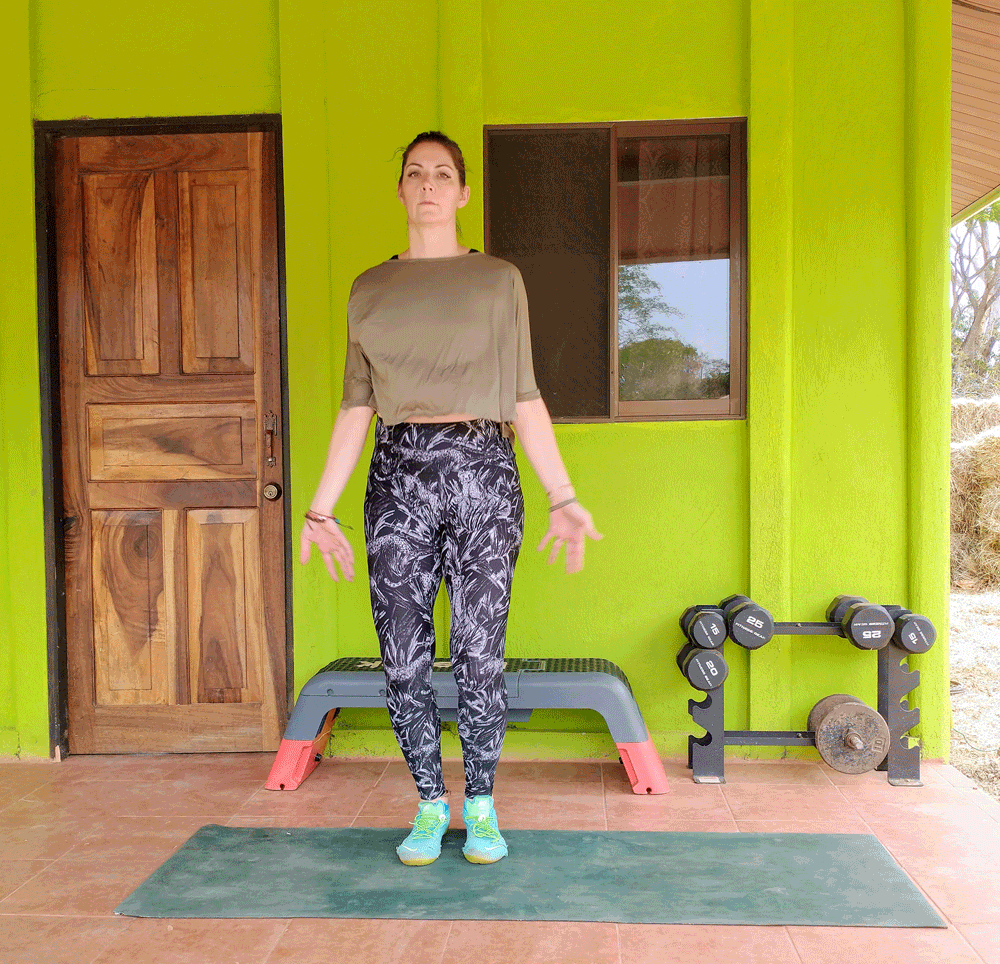
Jumping jacks
Jumping jacks are an excellent equipment-free cardio exercise to help you increase your heart rate quickly. Perform this exercise just like you remember from physical education class.
Start with your feet together, your arms at your sides. When the timer starts, jump up into the air, spreading your legs wide as you simultaneously sweep your arms out and over your head.
When your feet touch the ground, immediately jump back into the air and reverse the movement, bringing your legs back to center and your arms back to your sides.
Keep your knees slightly bent as you jump to help protect your joints, and try to land and stay on the balls of your feet to move at a quick pace.
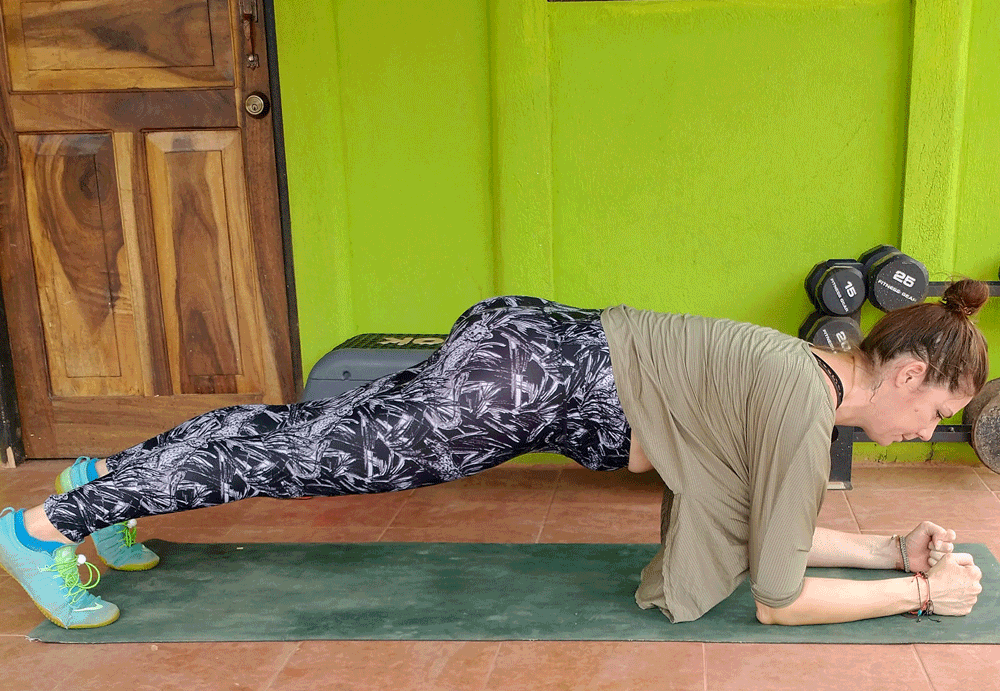
Plank up-downs
Plank up-downs target the entire front-half of your body, including your core, chest, shoulders, triceps, quads, and glutes. And because you’ll be constantly moving from a high plank to a low plank and back again, your lungs will get quite the workout, too.
Start in a low plank position, balanced on your forearms and the balls of your feet. Your body should form a straight line from heels to head, with your elbows under your shoulders and your core engaged.
When the timer starts, shift your weight slightly to the left, placing your right palm on the ground under your right shoulder. Shift your weight back to the right, extending your right elbow and pushing through your right palm to extend your left arm and place your left palm under your left shoulder. This is a high plank.
From here, “walk” your arms back to the starting position, shifting your weight left before placing your right forearm on the ground, then placing your left forearm on the ground, returning to the low plank. Continue the up-down cycle.
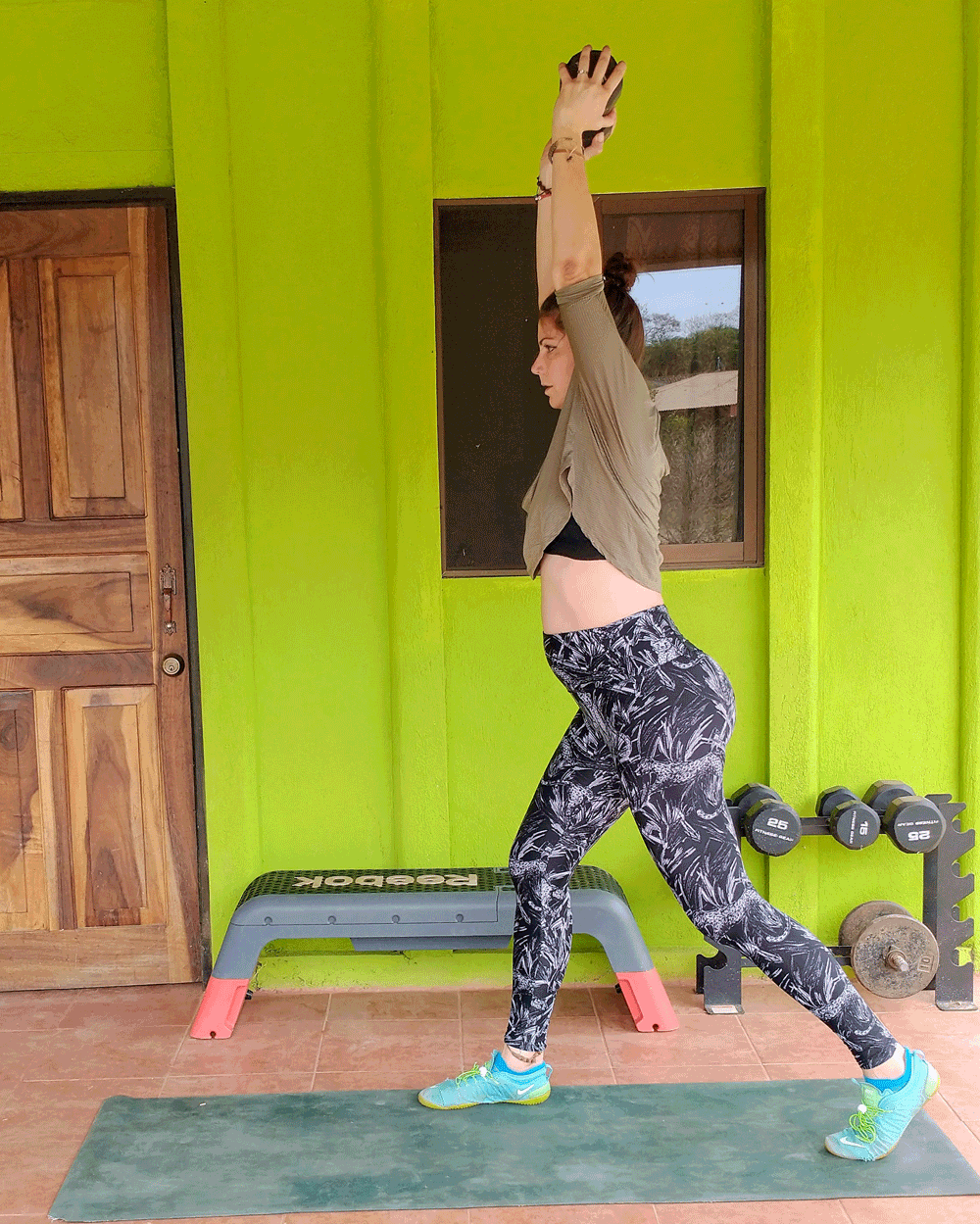
Walking overhead lunge
You can perform this exercise with dumbbells or with body weight only. The walking lunge keeps your entire body moving, hitting all the major muscle groups of your lower body and core. Keeping your arms lifted overhead also targets your shoulders, arms, and upper back.
Stand tall with your feet roughly hip-distance apart. If you’re using dumbbells, hold one in each hand, or hold a single dumbbell between both hands. Lift the dumbbells overhead so your arms are straight and in line with your shoulders.
Engage your core and take a step forward with your right foot, placing it firmly on the ground as the heel of your left foot lifts. Keeping your body centered between your legs, bend both knees, lowering your left knee toward the floor.
When both knees are bent at roughly 90-degree angles, press through the heel of your front foot and stand as you take a step forward with your left foot.
Perform another lunge on the left side. Continue walking forward, lunging with each step. If you’re limited on space, take two to four steps, then turn around and continue.
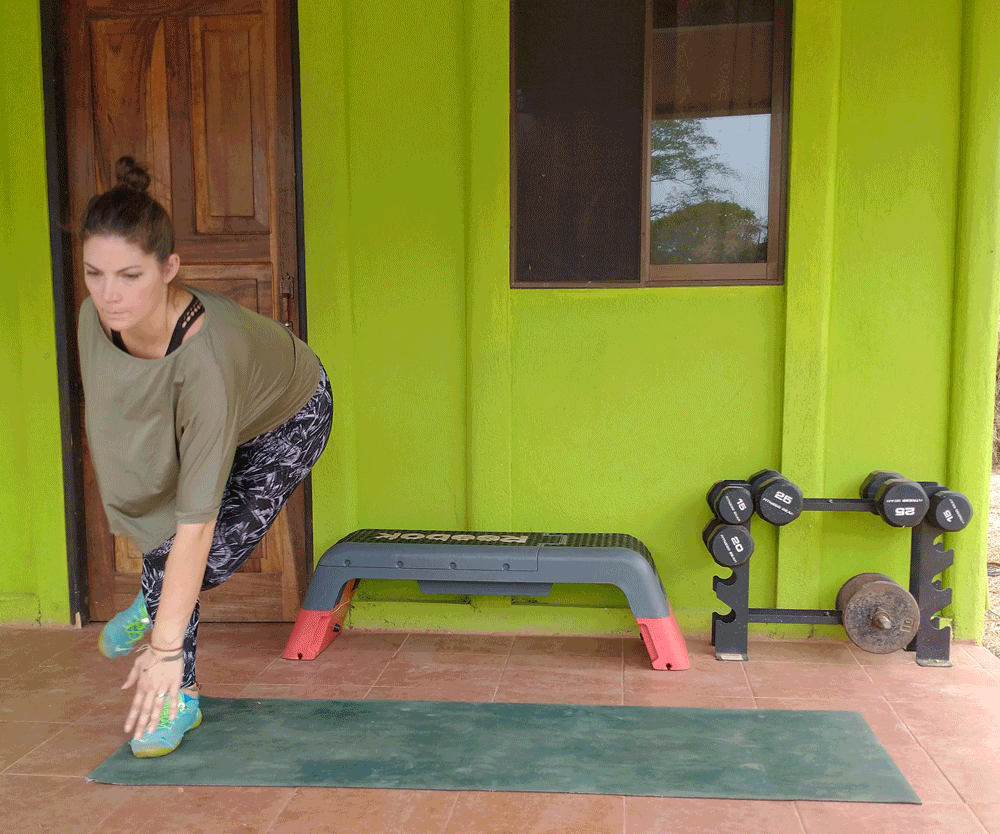
Skaters
Skaters are an excellent equipment-free cardiovascular exercise that uses side-to-side movement to target the entire lower body, including the glutes, hamstrings, quads, calves, abductors, adductors, and core.
Stand tall with your feet roughly hip-distance apart and your core engaged. Your arms should hang at your sides but be ready to swing back and forth to help with balance and movement.
With your left foot, step to the left, placing your weight on the ball of your left foot. Keep your knee slightly bent. Lean your torso slightly forward (keeping your core engaged to protect your low back) and sweep your right foot behind you and to the outside of your left foot as you simultaneously reach your right hand toward your left foot.
Immediately reverse the movement: lift your torso and arms to center as you press through your left foot and sweep your right foot from behind you and to the right, “hopping” to the opposite side.
When the ball of your right foot touches down (keeping your knee slightly bent and your torso leaned slightly forward), lift your left foot from the ground and sweep it backward and behind your right foot. This time, reach your left hand toward your right foot. The movement should look like a speed skater skating left and right.
Continue as fast as you can while maintaining good form and balance. If you need to touch your back foot to the ground with each step to help with balance and transition, do so.
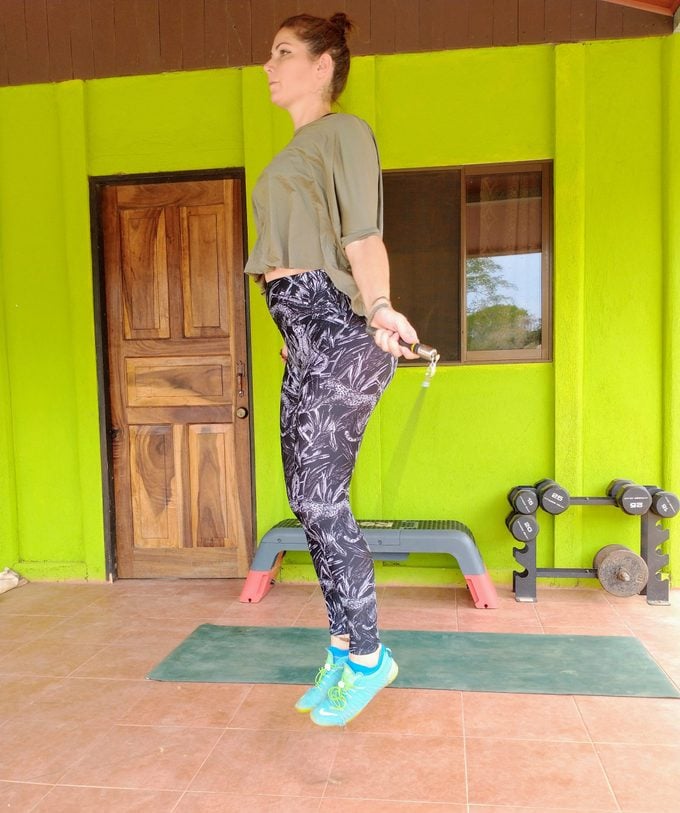
Jumping rope
You can perform the jumping rope exercise with or without an actual rope. If you don’t have a rope, pretending you’re spinning a rope in each hand.
This is an excellent cardiovascular move that focuses on the lower body. It’ll torch your calves and work your shoulders and core too.
Stand tall with your feet together, jump rope handles in each hand. The jump rope should start behind your feet. Use your shoulders and forearms to swing the rope up and over your head.
As it passes over your head and starts heading toward your feet in front of you, hop into the air, clearing the rope as it passes under your feet.
Continue swinging the rope smoothly, hopping over the rope each time it reaches your feet.
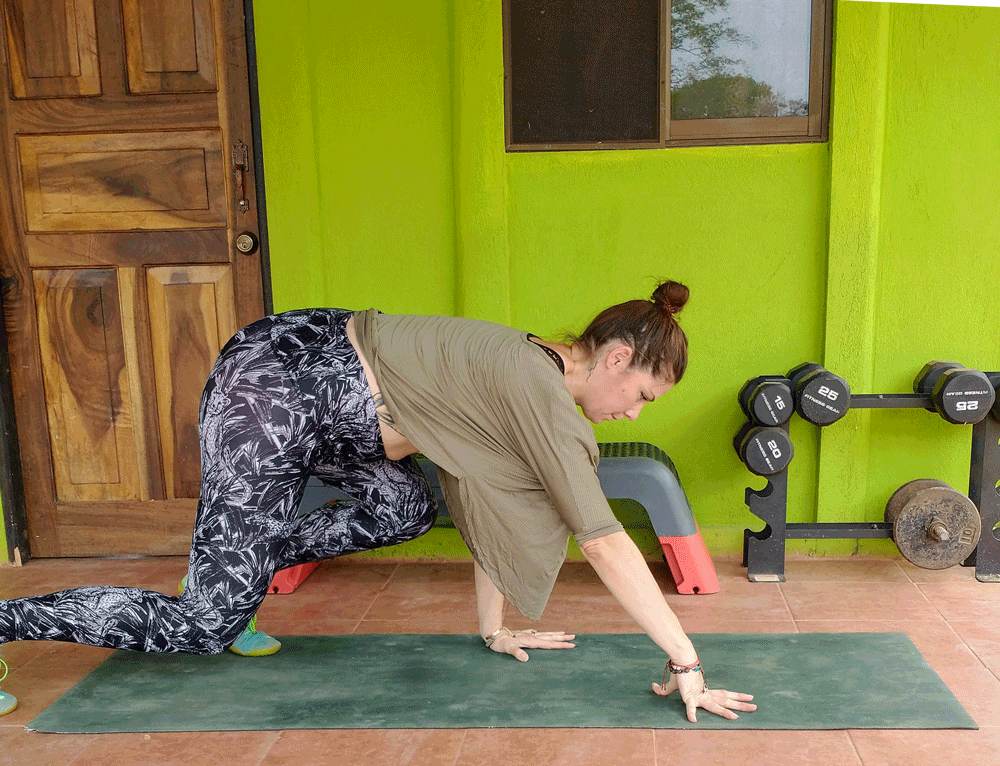
Bear crawls
Bear crawls are a tough cardio exercise you can do without equipment.
The movement targets your entire body, requiring engagement of the shoulders, chest, arms, core, quads, glutes, hamstrings, and calves.
Start on your hands and knees. Keep your knees under your hips and your hands under your shoulders. Flex your ankles and tuck your toes. Your toes and the balls of your feet should be engaged with the floor. Press through your feet and your hands and engage your abs to lift your knees from the ground.
When the timer starts, begin crawling forward in this position, first taking a “step” with your right hand and left foot, then following with your left hand and right foot.
Continue this forward movement, keeping your hips and glutes low, your knees close to the ground. If you’re working with limited space, take several steps forward with each hand and foot, then reverse the movement and bear crawl backward. Continue crawling forward and backward for the duration of the interval.
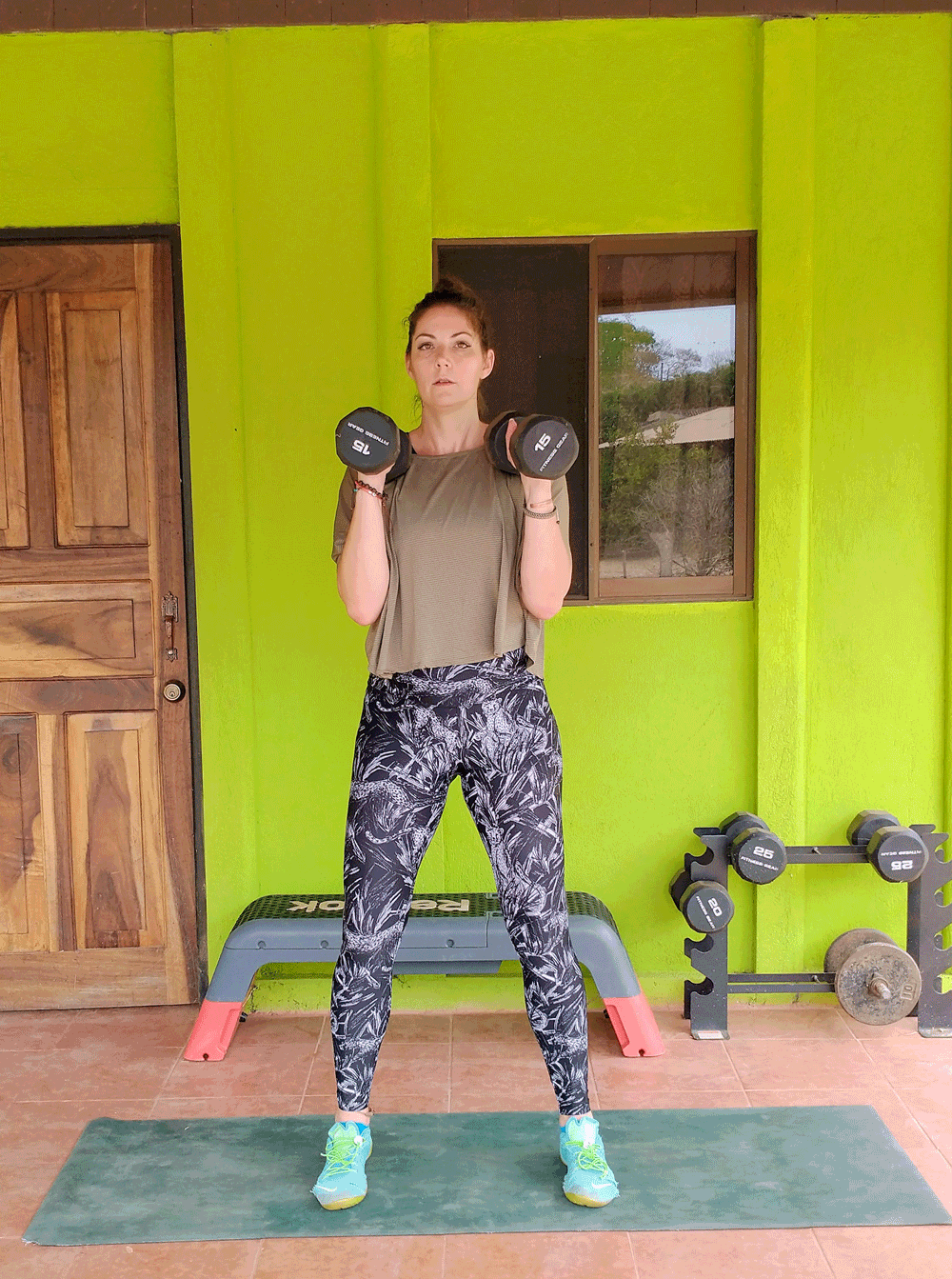
Squat press
The squat press is an excellent total-body strength-training move that hits all the major muscle groups. All you’ll need is a set of dumbbells. You’ll feel this one in your glutes, quads, hamstrings, core, and shoulders, and the continuous movement will keep your heart rate high.
Stand tall with your feet shoulder distance apart, your knees slightly bent, your core engaged, and a dumbbell in each hand. Hold the dumbbells at your shoulders, with your elbows bent and palms facing each other.
From here, press your hips back and bend your knees, lowering your glutes toward the floor. When you’ve lowered your hips as far as you comfortably can, press through your heels and return to standing.
As you rise, press your arms directly over your head, extending your elbows to perform a shoulder press. From here, lower the weight back to your shoulders. Immediately continue the movement.
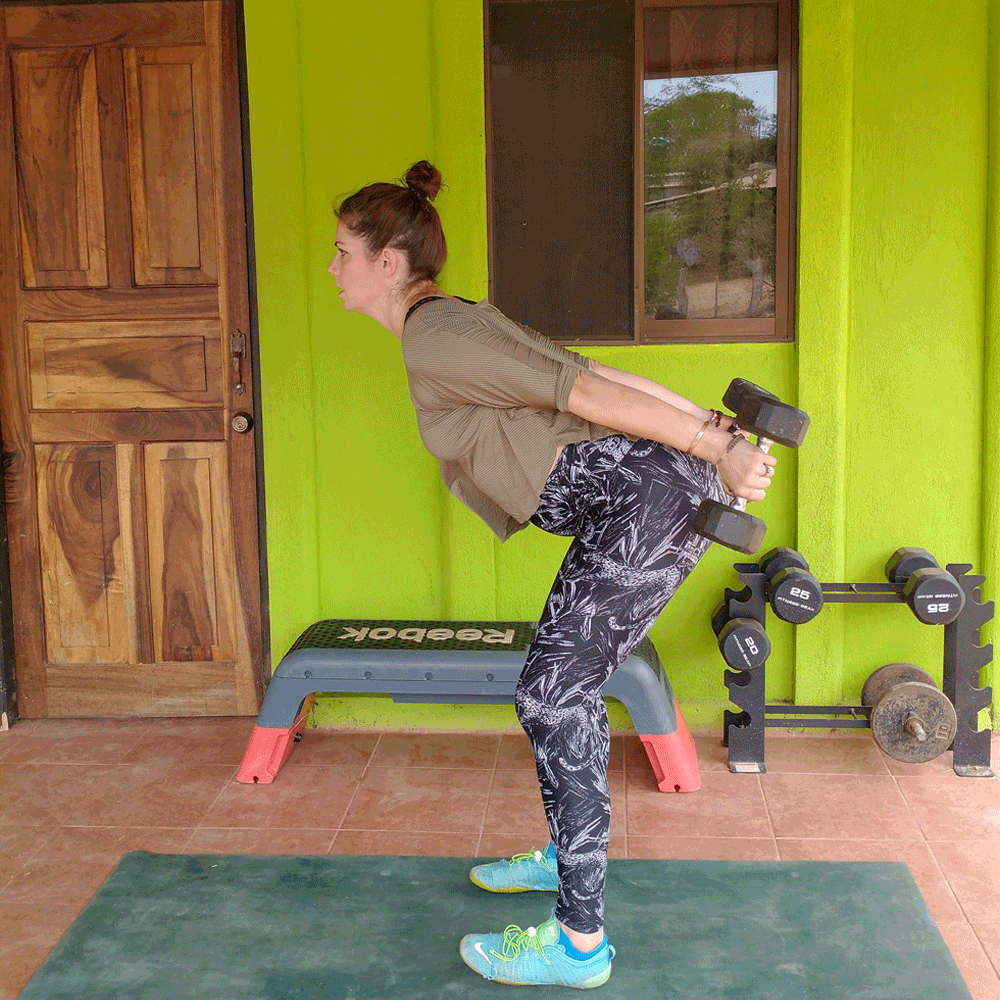
Skier swings
Skier swings are a dumbbell exercise that’s akin to a kettlebell swing in that it uses momentum to swing the dumbbells, requiring a major focus on your glutes, hips, hamstrings, and core to propel the exercise.
Stand with your feet hip distance apart, your knees slightly bent, your core engaged, and a dumbbell in each hand. Keeping your torso straight, press your hips backward and tip your torso slightly forward, taking the dumbbells behind you as you tip forward. Keep your arms straight as you press them backward.
Engage your hamstrings and glutes to control the movement, then powerfully press your hips forward, extending them fully as you squeeze your glutes and allow the momentum of this movement to swing the dumbbells up in front of your body. You aren’t lifting the dumbbells with your arms or shoulders; rather, you’re using the power generated from your lower body and core to help propel them forward.
When the dumbbells have reached as high as they can, allow them to naturally swing back down. As the dumbbells swing down, reverse the movement: press your hips back and allowing your torso to tip forward. Continue this swinging motion for the duration of the interval.
Keep in mind: it might take several swings before the momentum increases to the point where the dumbbells rise to the level of your shoulders as you stand. The important thing is to keep your core engaged and your back straight throughout.
The post 8 At-Home Exercises to Lose Belly Fat appeared first on The Healthy.
